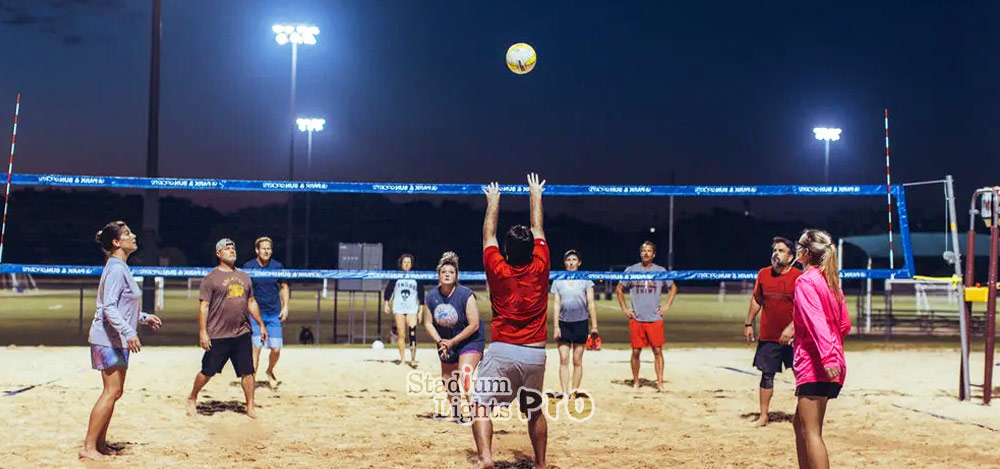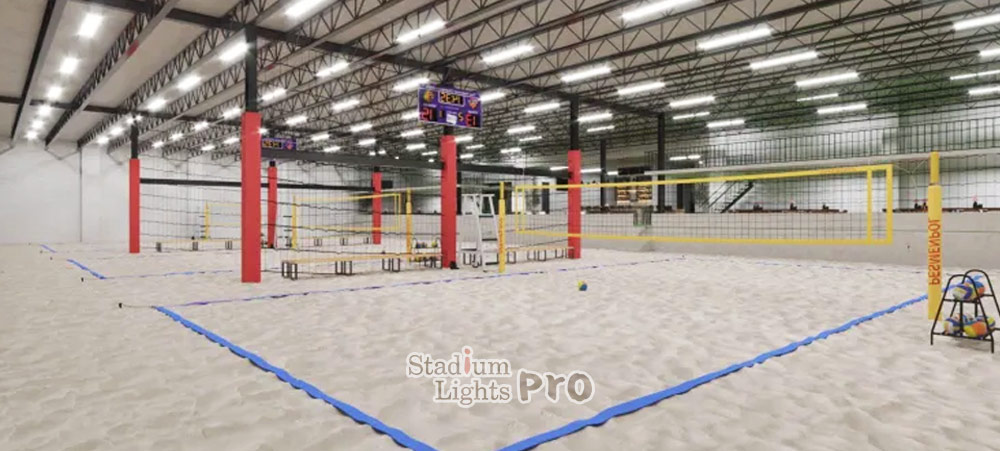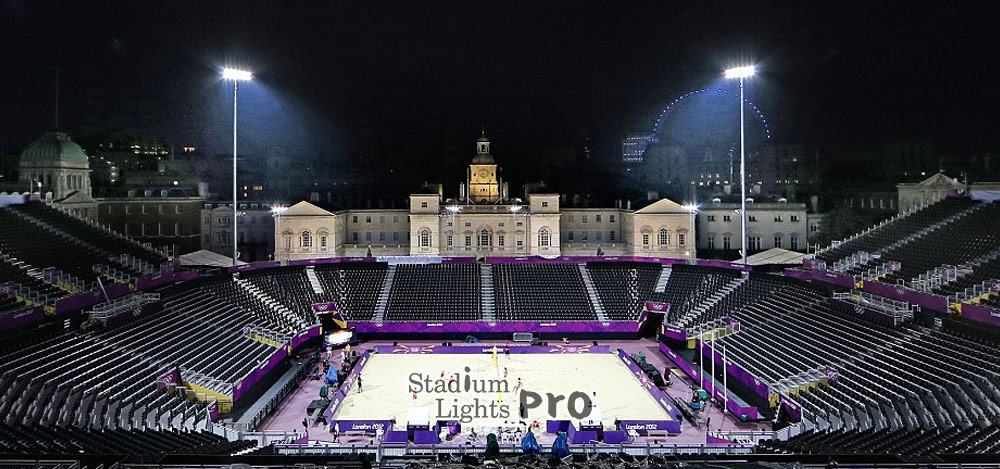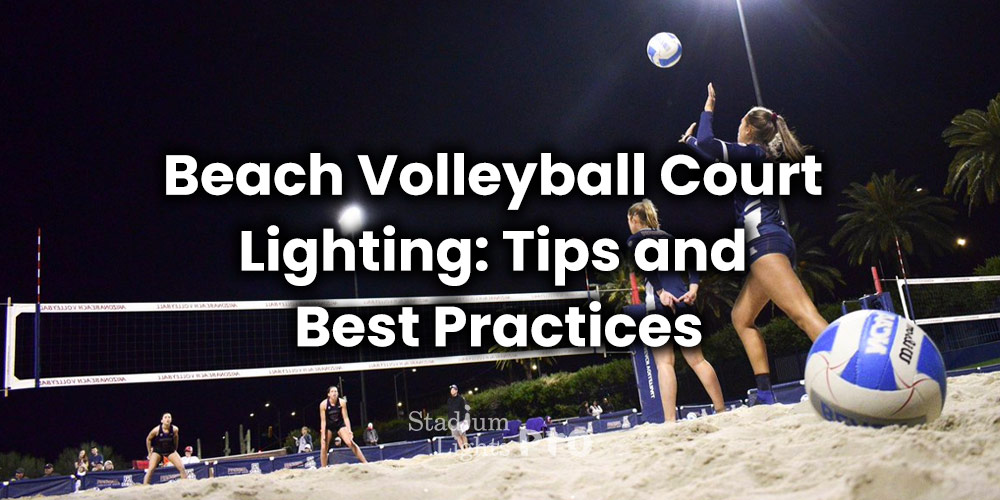Beach volleyball is a sport played on sand by two teams of two players each, in which the players hit a ball over a net and into the opponent’s court.
Proper lighting can ensure player safety by reducing the risk of accidents or injuries due to poor visibility. Good lighting can improve the overall playing experience by enhancing the visibility of the ball and the surrounding environment, which can help players react more quickly and accurately. In competitive play, proper lighting can also help ensure fair play by eliminating shadows and reducing glare. Finally, good lighting can help attract players and spectators to the beach volleyball court, and can enhance the overall atmosphere of the event.
Table of Contents
ToggleFactors to consider when designing lighting for beach volleyball courts
Brightness and intensity of light

The brightness of a light source is a measure of how much light it produces, while the intensity is a measure of the amount of light that is emitted in a particular direction.
Beach volleyball courts should have high levels of brightness and intensity in order to provide good visibility for players. This can help players see the ball more clearly, and can reduce the risk of accidents or injuries due to poor visibility. High levels of brightness and intensity can also help improve the overall playing experience by making the court look more attractive and inviting.
There are a few different ways to measure the brightness and intensity of light, including lumens and candelas. When designing lighting for a beach volleyball court, we need to consider the size and layout of the court, as well as the ambient light conditions and the preferences of the players.
How many lux do we need to light a beach volleyball court?
The amount of lux (a unit of illuminance) needed to light a beach volleyball court depends on a number of factors, including the size and layout of the court, the ambient light conditions, and the preferences of the players.
Beach volleyball courts should be lit to levels of at least 300-500 lux, although some sources recommend higher levels of 500-1000 lux or more. If the court is located in an area with very bright ambient light, lower levels of lighting may be sufficient. On the other hand, if the court is located in an area with low ambient light or is used for competitive play, higher levels of lighting may be necessary.
Lighting uniformity

Lighting uniformity refers to the evenness of the lighting across a given area. In the context of beach volleyball courts, lighting uniformity is essential because it can impact player visibility and performance. If the lighting is not uniform, it can create shadows or areas of high glare that can distract or disorient players.
There are a few different ways to measure lighting uniformity, including uniformity ratios and spacing criteria. Uniformity ratios are used to compare the level of lighting at the center of an area to the level of lighting at the edges, while spacing criteria are used to measure the distance between light fixtures and the resulting pattern of light on the surface below.
LED lighting is often recommended for beach volleyball courts because it can provide a more even distribution of light than other types of lighting. Also, it is necessary to ensure that the light fixtures are spaced appropriately and mounted at the correct angle to minimize shadows and glare. Proper maintenance of the light fixtures can also help to ensure that the lighting remains uniform over time.
Color temperature
When designing lighting for a beach volleyball court, it is necessary to consider the desired atmosphere and the color temperature of the light sources. A light source with a color temperature of around 4000-5000K is often recommended for beach volleyball courts, as it can provide good visibility and a vibrant atmosphere. However, the optimal color temperature may vary based on the specific needs and preferences of the players and the conditions of the court.
Number of lights used in beach volleyball court
To determine the optimal number of light fixtures for a beach volleyball court, we may consider the size and layout of the court, as well as the ambient light conditions and the preferences of the players.
The light fixtures should be spaced evenly around the court and mounted at the correct angle to minimize shadows and glare. It may also be necessary to use a combination of natural and artificial light sources to achieve the desired level of lighting.
Angle and direction of light
The angle and direction of light can have a significant impact on the lighting of a beach volleyball court. The angle of the light refers to the vertical orientation of the light source, while the direction of the light refers to the horizontal orientation.
It is best to mount light fixtures on poles or other structures that allow for adjustable angles and directions. This can help to ensure that the lighting is evenly distributed across the court and does not create shadows or areas of high glare that could impact player visibility or performance.
When setting the angle and direction of light fixtures for a beach volleyball court, it is critical to consider the size and layout of the court, as well as the ambient light conditions and the preferences of the players. The light fixtures should be positioned and angled in a way that provides good visibility for the players while minimizing shadows and glare. Besides, it may be necessary to use a combination of light fixtures at different angles and directions to achieve the desired level of lighting.
Shadow and glare control
Shadows and glare can negatively impact player visibility and performance, and can also reduce the overall enjoyment of the game.
In order to eliminate shadows on a beach volleyball court, we may consider the angle and direction of the light fixtures. The light fixtures should be positioned and angled in a way that minimizes the formation of shadows on the court. Using light fixtures with wide beam angles or using multiple light fixtures can help to reduce the formation of shadows.
To control glare on a beach volleyball court, we may reduce the intensity and brightness of the light fixtures, as well as the reflectivity of the surface of the court. Using light fixtures with lower levels of intensity and brightness, and selecting a surface with low reflectivity, can help to reduce glare on the court. Adopting light fixtures with shielding or other glare-reducing features can be effective in controlling glare.
Types of lighting systems for beach volleyball courts
Natural lighting
Natural lighting refers to the use of sunlight as a light source. Natural lighting can be a cost-effective and energy-efficient option for illuminating beach volleyball courts, and can also provide a pleasant and inviting atmosphere.
However, natural lighting is not always sufficient to provide the desired level of lighting for beach volleyball courts. The intensity and direction of natural light can vary significantly depending on the time of day, the weather, and the location of the court. In addition, natural light may not be available at all times, such as during nighttime or in cloudy or overcast conditions.
To maximize the use of natural lighting on a beach volleyball court, it may be necessary to use additional light fixtures or to install shading or other protective measures to mitigate the effects of direct sunlight. Generally, it is best to use a combination of natural and artificial lighting to ensure that the court is adequately lit and to provide flexibility in case of changes in the lighting conditions.
Artificial lighting
Artificial lighting refers to the use of light fixtures or other light sources that are not naturally occurring. Artificial lighting is often used in beach volleyball courts to supplement natural lighting or to provide illumination when natural light is not available.
There are a wide variety of artificial lighting options available for beach volleyball courts, including incandescent, fluorescent, and LED lighting. Each type of lighting has its own unique characteristics and benefits, and the best option will depend on the specific needs and preferences of the players and the conditions of the court.
LED lighting

LED (light-emitting diode) lighting is a type of artificial lighting that uses semiconductor technology to produce light. LED lighting is often used in beach volleyball courts because it can provide a number of benefits compared to other types of lighting.
One of the main benefits of LED lighting is its energy efficiency. LED beach volleyball court lights use less energy than other types of lighting, and can also produce more light per watt of electricity consumed. This can help to reduce energy costs and environmental impact. LED lighting is also known for its long lifespan and low maintenance requirements. LED lights have a longer lifespan than other types of lighting, and do not require frequent replacement. This can help to reduce maintenance costs and downtime.
LED lighting is also known for its versatility and flexibility. LED lights are available in a wide range of colors, intensities, and beam angles, and can be easily controlled and dimmed. This makes LED lighting a good option for beach volleyball courts, where the lighting needs may vary depending on the time of day, the weather, and the preferences of the players.
Temporary lighting for beach volleyball court
Temporary lighting refers to lighting systems that are designed to be set up and taken down as needed, rather than being permanently installed. Temporary lighting can be a good option for beach volleyball courts that are only used occasionally, or for courts that are used in different locations or under varying conditions.
There are a variety of temporary lighting options available for beach volleyball courts, including portable light fixtures, battery-powered lights, and event lighting. These types of lighting can be set up and taken down quickly and easily, and can be used to provide illumination for a variety of events, including recreational play, tournaments, and other sporting events.
Temporary lighting systems for beach volleyball courts should be designed to provide good visibility and a pleasant atmosphere, and should also be energy efficient and easy to maintain.
Best practices for installing and maintaining lighting on beach volleyball courts
Positioning and mounting of light fixtures
The position and orientation of the light fixtures can affect the intensity, direction, and distribution of light on the court, and can also impact the overall appearance of the lighting system.
It is best to mount light fixtures on poles or other structures that allow for adjustable angles and directions. This can help to ensure that the lighting is evenly distributed across the court and does not create shadows or areas of high glare that could impact player visibility or performance.
When positioning and mounting light fixtures for a beach volleyball court, it is necessary to consider the size and layout of the court, as well as the ambient light conditions and the preferences of the players. The light fixtures should be spaced evenly around the court and mounted at the correct angle to minimize shadows and glare. In addition, it may be necessary to use a combination of light fixtures at different angles and directions to achieve the desired level of lighting.
Wiring and electrical considerations
Proper wiring and electrical installation is necessary to ensure the safe and reliable operation of the lighting system, and to prevent accidents or injuries.
When designing the wiring and electrical system for a beach volleyball court, we need to consider the size and layout of the court, as well as the type and number of light fixtures. The electrical system should be designed to provide sufficient power to the light fixtures, and should also include appropriate safety features such as circuit breakers and grounding.
Besides the wiring and electrical installation, it is essential to consider the maintenance and repair of the lighting system. Regular inspection and maintenance of the wiring and electrical system can help to ensure that the lighting system remains safe and reliable over time.
Maintenance and cleaning
Regular maintenance and cleaning can help to ensure that the lighting system remains safe and reliable, and can also help to extend the lifespan of the light fixtures.
There are a few key tasks that should be performed as part of the maintenance and cleaning of a lighting system for a beach volleyball court. These tasks may include:
- Inspecting the light fixtures and wiring for damage or wear
- Testing the operation of the light fixtures and making any necessary repairs or adjustments
- Cleaning the light fixtures and surrounding areas to remove dirt, sand, debris, or other contaminants
- Replacing burnt-out bulbs or other components as needed
We may follow the manufacturer’s recommendations for maintenance and cleaning of the light fixtures. This can help to ensure that the light fixtures are properly cared for and that any necessary repairs or adjustments are made in a timely manner.
In addition to regular maintenance and cleaning, it is recommended to have a plan in place for emergency repairs or maintenance in case of unexpected issues with the lighting system. This can help to minimize downtime and ensure that the lighting system is available for use when needed.
Conclusion
There are a number of factors to consider when designing lighting for a beach volleyball court, including the brightness and intensity of the light, the uniformity of the lighting, the color temperature of the light, the number of light fixtures, the angle and direction of the light, shadow and glare control, and the use of natural and artificial light sources.
If you are interested in designing a beach volleyball court lighting system, we encourage you to contact us for a free design consultation. Our team of lighting experts has extensive experience designing lighting systems for beach volleyball courts, and we can help you create a lighting plan that meets your specific needs and preferences.
During the design consultation, we will work with you to understand the size and layout of your beach volleyball court, as well as your goals for the lighting system. We will also consider factors such as the intensity and color temperature of the light, the distribution of the light across the court, and the potential for shadows and glare.
After the consultation, we will provide you with a customized lighting design plan that includes detailed recommendations for light fixtures, wiring and electrical considerations, and maintenance and cleaning. The plan will also include cost estimates for the lighting system, so you can make an informed decision about your lighting needs.
We look forward to working with you to create a lighting system that enhances the enjoyment and safety of your beach volleyball court. Please don’t hesitate to contact us to schedule your free design consultation.

